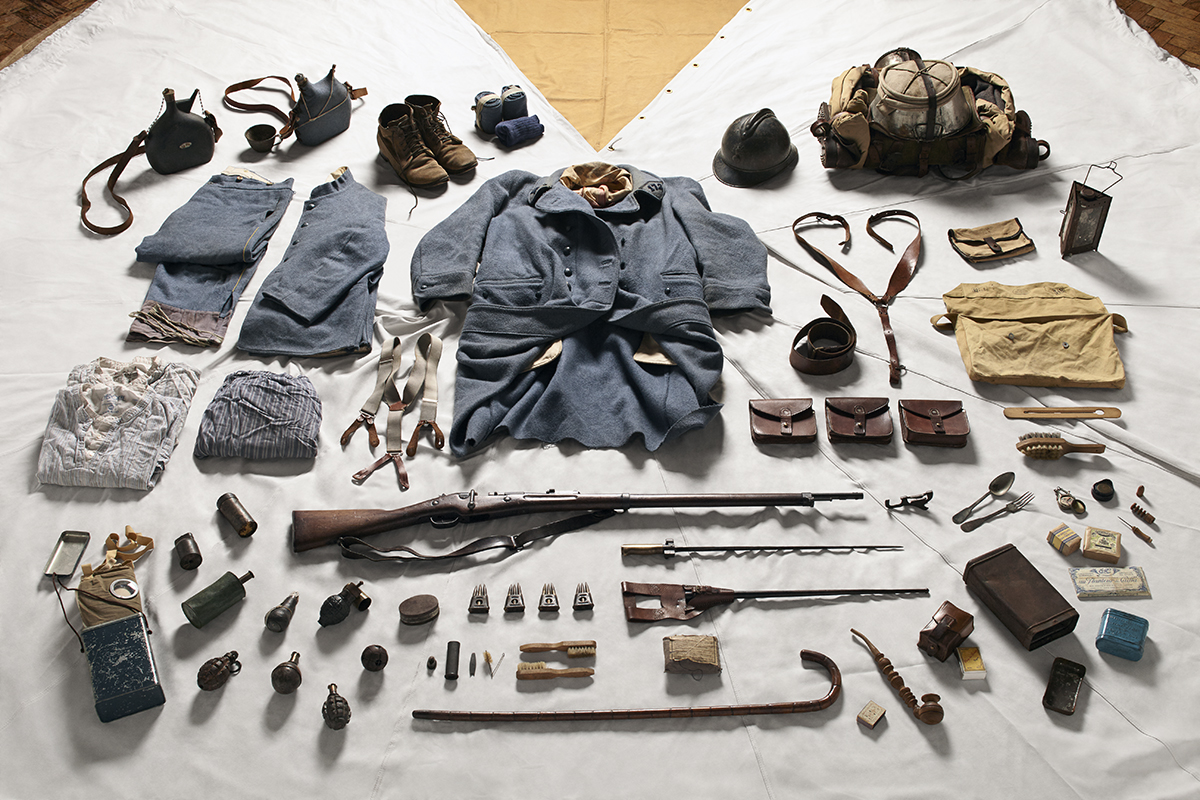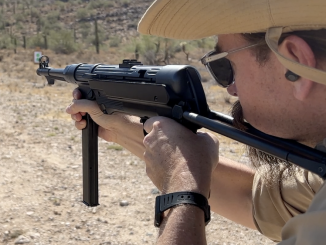Walther was founded as a rifle making company in the 1880s, and expanded into the flourishing market for semiautomatic pocket pistols around 1910. The Model 3 was the company’s first .32 ACP caliber pistol, and was a very small gun. With a 6-round capacity it offered one round more than the Pieper Bayard, the only smaller .32 available at the time. Compared to guns like the FN 1910, it was quite tiny indeed. Only about 3500 were produced between its introduction in 1913 and the end of WW1, and its production was massively superseded by the larger but otherwise very similar Model 4, which was ordered in significant quantity by the German military during the war. Walther development after WW1 would return to a focus on the .25 ACP cartridge.
Related Articles

Accessories
World War One Soldiers’ Loadouts
A reader sent me a link to a pretty cool image gallery showing the basic clothing and equipment of five different major combatant powers from mid-WWI. I have re-uploaded the individual photos in case the […]

Semiauto pistol
Slow Motion: Interesting Extractor Problem (Schwarzlose 1898)
Many people don’t realize that an extractor is not strictly necessary in many types of pistols – several early blowback models (notably the Bergmann 1896, as well as some later Spanish pistols) did not even […]

Reproduction
Introducing the BD-38: A New Production Copy of the German MP-38
There has never been a proper semiauto version of the MP40 available in the US, until now. SSD (Sport-Systeme Dittrich) is a German company that has been making semiauto copies of German WW2 small arms […]

“Say hello to my little friend!” Bang!
Love the bluing on the extractor and safety catch. Amazing condition for a 108 years old gun
“Walther Model 3”
Unblinking eye have article about it: https://unblinkingeye.com/Guns/WM3/wm3.html
it include side by side photo of Walther Modell 3 and Walther Modell 4 presenting difference in their size and similarity in external aesthetic.
“Walther development after WW1 would return to a focus on the .25 ACP cartridge.”
Not only, in mid 1920s Walther developed automatic pistol for 9×19 Parabellum cartridge with two-column magazine holding 16 rounds. I think it could be counted as “forgotten” on basis of being early high-capacity automatic pistol. See photos:
http://historypistols.ru/blog/pistolety-pod-unitarnyj-patron-avtomaticheskie/eksperimentalnyj-pistolet-valter-s-rychazhnym-mexanizmom-zapiraniya-walther-toggle-action-pistol/
unlike earlier Walther Modell 6 for 9×19 Parabellum cartridge this experimental automatic pistol did NOT use pure blow-back principle.
“focus on the .25 ACP cartridge”
It is worth highlighting that 6,35 mm Browning cartridge was introduced in Europe it become instant, maybe even surprise*success, unlike United States when it was offered, but do not lead to creation of great bunch of automatic pistols models firing that cartridge.
Fact that they later offered also http://www.imfdb.org/wiki/Mauser_WTP suggest that market for 6,35 mm automatic pistol was great at that time, allowing manufacturers to made more than 1 pattern for that cartridge.
*note that Mauser decided in 1910 to scale its own design https://modernfirearms.net/en/handguns/handguns-en/germany-semi-automatic-pistols/mauser-1910-14-34-eng/ for then new-fangled cartridge, rather than develop anything from scratch, suggesting that they detected need to have such gun in offer and considering it to be of big priority as they decided to modify existing design, than creating entirely new one. Fact that they did not have anything in that size range already, hint that it was surprise.
So many tiny vest-pocket handguns were made in those days. I wonder if they were being purchased with practical thoughts in mind, or were slso seen as a fashy gadget, similar to today’s smartphones?
At the time, street crime in European cities was nearly as widespread as it is in major cities there and in the U.S. today. The difference was that the governments had not yet passed laws disarming law-abiding citizens.
So yes, people had very good reasons for buying concealable handguns.
cheers
eon
One aspect is the introduction of a rapid fire event in Germany after WW1. There was no lower limit on the cartridge power. This was one reason for the 6.35 mm (.25 ACP) Walther Mod. 8, which was large enough for holding steady and had sights making well aimed shot possible. One of its users was Cornelius van Oyen, who later won 1936 Olympic Rapid Fire with a .22lr Walther.
I think the rare Walther PP pistols in 6.35 mm also have their origin as a competition weapon.
“(…)large enough for holding steady and had sights making well aimed shot possible.(…)”
This might be factor in popularizing 6,35 mm caliber, but I think of limited influence, as most automatic pistol firing 6,35 mm Browning cartridge made in Germany at that time, see for example: http://www.vestpockets.bauli.at/archiv/archiv.htm chapter DEUTSCHLAND [though stay alert, as this table contain not only 6,35 mm] were into vest pocket size, which was even sometimes denoted in designation (like Mauser WTP where WT stands for WestenTaschen meaning literally [for] pockets [of] vests)
I would not be surprised if more 6.35 mm rounds were fired in the contemporary rapid fire competition than from vest pocket pistols intended for personal defence.
By the way, in Wikipedia we have been able to read this about the .25 ACP (since 23 April 2008): “The tiny cartridge has also been used in some precision crafted target pistols.” [https://en.wikipedia.org/wiki/.25_ACP#Performance] There is no example or source. I wonder, what did the editor mean?
One might ask why 6.35 mm and not .22 lr. The latter only started to become popular after WW1 in Germany and as a rifle cartridge at that. Shooting sports using smallbore ammunition as we know it today was in its infancy in Germany after WW1.
Simply put, a .25 ACP subcompact auto is more feed-reliable than a .22 rimfire. And back then, nobody believed in a “one-shot stop”. They wanted a pistol that would keep shooting as long as they kept pulling the trigger and there were rounds in the magazine.
It should be noted that John Moses Browning could have designed his Model 1900 and “Baby Browning” defense pistols around the .22 rimfire, which by that time had been around for over four decades and had made the transition from black powder to smokeless powder. Instead, he designed his own cartridges, the 7.65mm and 6.35mm, with his trademark semi-rim, to ensure that the pistols both functioned reliably and hit hard enough to get the job done.
Note that while a lot of people denigrate the killing power of the .25 ACP, I’ve never met anybody who volunteered to be shot with it unless they were wearing at least a Threat Level II vest.
cheers
eon
“(…)7.65mm(…)”
This cartridge is distinctively bigger, on par with then used .32 S&W Long, I do not see possibility of providing similar performance via .22 rim-fire cartridge.
“(…)denigrate the killing power of the .25 ACP(…)”
According to Korovin automatic pistol manual, bullet fired from that automatic pistol at distance 25 mm, goes through 2 and become jammed into 3rd plank, for plank material: pine, plank thickness 25 mm each and spaces between planks 75 mm each.
“(…)had made the transition from black powder to smokeless powder.(…)”
But did it positively ended by that time? One of reason given for Winchester Model 1903 self-loading rifle using special .22 rim-fire cartridge rather than common .22 rim-fire cartridge is to prevent inserting black-powder loaded cartridges. Remington Model 16 self-loading rifle introduced few years later also used own .22 rim-fire (incompatible both with common .22 rim-fire and Winchester Model 1903 one). Its beyond my ability to detect if that was just cargo cult example (Winchester made so, so we also) or answer to real danger.
“(…).22 rimfire(…)”
Interestingly while 6,35 mm Browning is often compared to .22 rim-fire, dimensions-wise it is very close to other rim-fire cartridge (which today has status “obsolete”) namely .25 Stevens Short RF. Just compare dimensions of these:
http://www.municion.org/Stevens/25StevensShort.htm
http://municion.org/6_35/6_35.htm
Also note that unlike common .22 rim-fire, .25 Stevens Short RF is inside-lubricated making in further closer to 6,35 mm Browning.
From identical pocket pistols of the same barrel length, let’s say 2 inches, the .22 LR and the 6.35mm Browning offer virtually identical ballistics, that being bullets weighing 40 grains or so moving at around 800 feet per second. So what was John Browning thinking?
The things that make the 6,35mm Browning a more desirable cartridge than the .22 rimfires for use in defensive pocket pistols are the things that, by design, make it a more reliable cartridge.
First, there’s priming. A centerfire cup and anvil primer is exponentially more reliable than any rimfire. Period. This is true with today’s modern ammunition, and I suspect it was even more true in 1905. If you don’t believe it, you’re not shooting enough. Some competitive venues shooting action pistol and steel challenge matches will bring this point home. You’ll get to experience lots of .22 LR misfires first hand and witness many more. On the other hand, I’ve never had a small pistol primer fail to fire.
Secondly, and somewhat related to the first point, the 6.35mm gives us a rim of solid brass for the extractor to yank on. Sure, not a big deal….until that hollow rim blows off a 22 LR round and leaves the rest of the case in the chamber. This has happened to me personally 3 times in 35 years of shooting, so I’m due for another sometime in the next 5 years, lol. Granted, it’s not as common as a misfire caused by bad priming, but it deadlines the gun until you can get it field stripped and find your stuck case extractor tool.
Then there’s the soft lead healed bullets. Open a box of Remington or Federal .22 Long Rifle ammo. Find the rounds that allow you to spin the bullets in their cases. Grip them firmly and bend them over and out of the cases with just your fingers. Dump the powder out and marvel at the sturdy build quality of your ammunition. Imagine what this stuff was like in 1905.
Marketing always has a big part to play in this as well. Imagine a new Browning pistol chambered for a new centerfire round which was, by design, optimized for reliability in the pistol it was introduced in. Imagine a new Colt pistol for the new Colt .25 Automatic Colt Pistol round, and it looks like a like a real cartridge with a pretty jacketed bullet on top instead of lead bullet dipped in beeswax.
I think Browning was correct by not tying his reputation to the least reliable ammo available at the time.
“pretty jacketed bullet on top instead of lead bullet dipped in beeswax.”
Nonetheless .22 rim-fire could be equipped with FMJ bullet if need arise, see T-42 https://en.wikipedia.org/wiki/.22_Long_Rifle#Full_metal_jacket
Though still, problem of positive attachment case-bullet remains. To prevent if from happening you need different cartridge – inside lubricated, not outside lubricated. Such trait is not mutually exclusive with being rim-fire, see for example .22 WRF https://en.wikipedia.org/wiki/.22_Winchester_Rimfire but even then problems with reliable feeding of rimmed cartridge through box magazine in automatic pistol.
Friends,
You have to experience for yourselves the gratification of a vested suit displaying your grandfather’s gold chain, watch in the left vest pocket and the Baby Browning in the right pocket.
One is fit to sally forth and spit in the face of one’s devils.
I love my Walther 3. It was the mystery gun of the internet for a long time.
Took it to the NRA convention and showed it to the Walther people. They didn’t even have a picture of one on their time line of Walther Guns. EVERYBODY came running to see it and take pics.
Nice little shooter for a gun with such rudimentary sights.